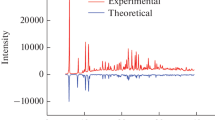Summary
Reactions of L = PHPh2 or PMePh2 with [MCl(CO)2(η3-C3H4R)(MeCN)2] (M = Mo, R = H or Me; M = W, R = H) in MeOH involve initial substitution to give [MCl(CO)2(η3-C3H4R)L2]. In MeCN, an excess of tertiary phosphine readily causes reductive elimination of allyl halide with the formation ofmer-[M(CO)2(MeCN)L3]. The molybdenum analogue can also be produced in high yields by reacting PMePh2 with either [Mo(CO)2(η3-C3H5)(MeCN)3]BF4 or Ph4As[Mo2Cl3(CO)4(η3-C3H5)2]. During these reactions, the new [MCl2(CO)2(η3-C3H5)(PMePh2)]− anions were formed and isolated as their σ-allylphosphonium salts. Under forcing conditions, reactions involving PHPh2 also resulted in elimination of the allyl group giving high yields ofcis-M(CO)2(PHPh2)4. The relevance of these observations on the mechanism of the reduction process are discussed.
Similar content being viewed by others
References
H. Friedel, I. W. Renk and H. tom Dieck,J. Organometal. Chem., 77, 313 (1977).
F. Hohmann and H. tom Dieck,J. Organometal. Chem., 85, 47 (1975).
F. Hohmann,J. Organometal. Chem., 137, 315 (1977).
H. tom Dieck, F. Hohmann, M. Form, T. Mack and I. W. Renk,J. Less-Common Mets., 54, 221 (1977).
F. Hohmann, H. tom Dieck, T. Mack and D. Leibfritz,J. Organometal. Chem., 132, 255 (1977).
R. D. Adams, D. F. Chodosh, J. W. Faller and A. M. Rosan,J. Am. Chem. Soc. 101 2570 (1979).
B. J. Brisdon and K. E. Paddick,J. Organometal. Chem., 149, 113 (1978).
M. G. B. Drew, B. J. Brisdon, D. A. Edwards and K. E. Paddick,Inorg. Chim. Acta, 35, L381 (1979).
B. J. Brisdon and M. Cartwright,J. Organometal. Chem., 164, 83 (1979).
A. T. T. Hsieh and B. O. West,J. Organometal. Chem., 112, 285 (1976).
B. J. Brisdon and A. A. Woolf,J. Chem. Soc. Dalton Trans., 291 (1978).
M. Boyer, personal communication.
M. Boyer, J. C. Daren and Y. Jeannin,Abstr., 9th International Conf. Organometal. Chem. Dijon, France, September 3–7, 1979, No. P36W.
K. E. Paddick, unpublished observations.
J. M. Jenkins and B. L. Shaw,J. Chem. Soc. A, 1407 (1966).
M. Aresta and A. Sacco,Gazz. Chim. Ital., 102, 755 (1972).
C. A. McAuliffe (Ed.),Transition Metal Complexes of Phosphorus, Arsenic and Antimony Ligands, Macmillan, London, 1973, ch. 10. We thank the S.R.C. for the award of a studentship (to K.E.P.).
Author information
Authors and Affiliations
Rights and permissions
About this article
Cite this article
Brisdon, B.J., Edwards, D.A. & Paddick, K.E. Reactions of diphenylphosphine and methyldiphenylphosphine with (η3-allyl)dicarbonylchlorobis(methyl cyanide)molybdenum and-tungsten: Mechanistic implications in the reductive elimination of allyl halides. Transition Met Chem 6, 83–86 (1981). https://doi.org/10.1007/BF00626111
Received:
Issue Date:
DOI: https://doi.org/10.1007/BF00626111




